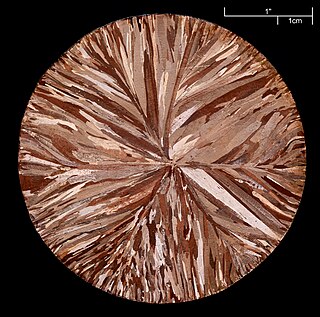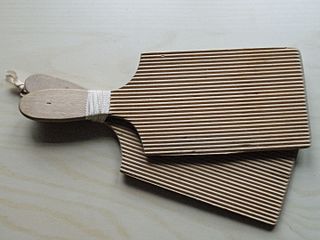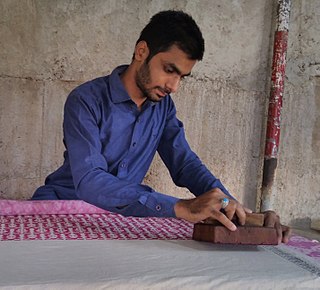
A quilt is a multi-layered textile, traditionally composed of two or more layers of fabric or fiber. Commonly three layers are used with a filler material. These layers traditionally include a woven cloth top, a layer of batting or wadding, and a woven back combined using the techniques of quilting. This is the process of sewing on the face of the fabric, and not just the edges, to combine the three layers together to reinforce the material. Stitching patterns can be a decorative element. A single piece of fabric can be used for the top of a quilt, but in many cases the top is created from smaller fabric pieces joined, or patchwork. The pattern and color of these pieces creates the design. Quilts may contain valuable historical information about their creators, "visualizing particular segments of history in tangible, textured ways".

Terracotta, also known as terra cotta or terra-cotta, is a clay-based non-vitreous ceramic fired at relatively low temperatures. It is therefore a term used for earthenware objects of certain types, as set out below.

A rubber stamp is an image or pattern that has been carved, molded, laser engraved, or vulcanized onto a sheet of rubber. Rubber stamping, also called stamping, is a craft in which some type of ink made of dye or pigment is applied to a rubber stamp, and used to make decorative images on some media, such as paper or fabric.

Glassblowing is a glassforming technique that involves inflating molten glass into a bubble with the aid of a blowpipe. A person who blows glass is called a glassblower, glassmith, or gaffer. A lampworker manipulates glass with the use of a torch on a smaller scale, such as in producing precision laboratory glassware out of borosilicate glass.

Injection moulding is a manufacturing process for producing parts by injecting molten material into a mould, or mold. Injection moulding can be performed with a host of materials mainly including metals, glasses, elastomers, confections, and most commonly thermoplastic and thermosetting polymers. Material for the part is fed into a heated barrel, mixed, and injected into a mould cavity, where it cools and hardens to the configuration of the cavity. After a product is designed, usually by an industrial designer or an engineer, moulds are made by a mould-maker from metal, usually either steel or aluminium, and precision-machined to form the features of the desired part. Injection moulding is widely used for manufacturing a variety of parts, from the smallest components to entire body panels of cars. Advances in 3D printing technology, using photopolymers that do not melt during the injection moulding of some lower-temperature thermoplastics, can be used for some simple injection moulds.

The Federal Duck Stamp, formally known as the Migratory Bird Hunting and Conservation Stamp, is an adhesive stamp issued by the United States federal government that must be purchased prior to hunting for migratory waterfowl such as ducks and geese. It is also used to gain entrance to National Wildlife Refuges that normally charge for admission. It is widely seen as a collectable and a means to raise funds for wetland conservation, with 98% of the proceeds of each sale going to the Migratory Bird Conservation Fund.

Eero Aarnio is a Finnish designer, noted for his innovative furniture designs in the 1960s, such as his plastic and fibreglass chairs. He was born in Helsinki.

Vacuum forming is a simplified version of thermoforming, where a sheet of plastic in various forms of High Impact Polystyrene Sheet (HIPS) for low impact products, or ABS for bathroom shower trays, and HDPE for exterior vehicle parts, plus various other types of vacuum formable materials) is heated to a forming temperature, stretched onto a single-surface mould, and forced against the mould by a vacuum. This process can be used to form plastic into permanent objects such as turnpike signs and protective covers. Normally draft angles are present in the design of the mould to ease removal of the formed plastic part from the mould.
Thingmaker, also called Creepy Crawlers, is an activity toy made by Mattel, beginning in 1964. The toy consists of a series of die-cast metal moulds resembling various bug-like creatures, into which is poured a liquid chemical substance called "Plasti-Goop", which comes in assorted colours. The mould is then heated to about 390 °F (199 °C) in an open-face electric hot plate oven. The Plasti-Goop is cured by the heat, and when cooled forms semi-solid, rubbery replicas which can be removed from the mould.

Continuous casting, also called strand casting, is the process whereby molten metal is solidified into a "semifinished" billet, bloom, or slab for subsequent rolling in the finishing mills. Prior to the introduction of continuous casting in the 1950s, steel was poured into stationary molds to form ingots. Since then, "continuous casting" has evolved to achieve improved yield, quality, productivity and cost efficiency. It allows lower-cost production of metal sections with better quality, due to the inherently lower costs of continuous, standardised production of a product, as well as providing increased control over the process through automation. This process is used most frequently to cast steel. Aluminium and copper are also continuously cast.

Scotch hands are wooden spatulas used when making butter. They are used to press freshly churned butter to remove the watery buttermilk during the butter finishing process, as well as to distribute salt through the butter. Removing the buttermilk and adding salt helps to prevent rancidity in finished butter. One side of the paddle will be ribbed or grooved to allow the buttermilk to drain away from the butter during pressing. The ungrooved side may be used for shaping the butter into final form. The highest quality Scotch hands are made out of sycamore wood, but they can also be made out of metal.

Butter sculptures are three-dimensional works of art created with butter, a dairy product made from the fat and protein components of churned cream. The works often depict animals, people, buildings and other objects. They are best known as attractions at state fairs in the United States as lifesize cows and people, but can also be found on banquet tables and even small decorative butter pats. Butter carving was an ancient craft in Tibet, Babylon, Roman Britain and elsewhere. The earliest documented butter sculptures date from Europe in 1536, where they were used on banquet tables. The earliest pieces in the modern sense as public art date from ca. 1870s America, created by Caroline Shawk Brooks, a farm woman from Helena, Arkansas. The heyday of butter sculpturing was about 1890–1930, but butter sculptures are still a popular attraction at agricultural fairs, banquet tables and as decorative butter patties.

Decorative concrete is the use of concrete as not simply a utilitarian medium for construction but as an aesthetic enhancement to a structure, while still serving its function as an integral part of the building itself such as floors, walls, driveways, and patios.

Leather crafting or simply leathercraft is the practice of making leather into craft objects or works of art, using shaping techniques, coloring techniques or both.

Robin Day, OBE, RDI, FCSD was one of the most significant British furniture designers of the 20th century, enjoying a long career spanning seven decades. An accomplished industrial and interior designer, he was also active in the fields of graphics and exhibitions.

Woodblock printing on textiles is the process of printing patterns on fabrics, typically linen, cotton, or silk, by means of carved wooden blocks.

Charles Eames and Ray Eames were an American married couple of industrial designers who made significant historical contributions to the development of modern architecture and furniture through the work of the Eames Office. They also worked in the fields of industrial and graphic design, fine art, and film. Charles was the public face of the Eames Office, but Ray and Charles worked together as creative partners and employed a diverse creative staff. Among their most recognized designs is the Eames Lounge Chair and the Eames Dining Chair.

Casting is a manufacturing process in which a liquid material is usually poured into a mold, which contains a hollow cavity of the desired shape, and then allowed to solidify. The solidified part is also known as a casting, which is ejected or broken out of the mold to complete the process. Casting materials are usually metals or various time setting materials that cure after mixing two or more components together; examples are epoxy, concrete, plaster and clay. Casting is most often used for making complex shapes that would be otherwise difficult or uneconomical to make by other methods. Heavy equipment like machine tool beds, ships' propellers, etc. can be cast easily in the required size, rather than fabricating by joining several small pieces. Casting is a 7,000-year-old process. The oldest surviving casting is a copper frog from 3200 BC.

Variety Unit is an exhibit building at Shelburne Museum in Shelburne, Vermont.

Kaak or Kaak el-Eid, is a small circular biscuit that originated in Egypt and is eaten across the Arab world to celebrate Eid al-Fitr. It is covered with powdered sugar and can be stuffed with ʿagameyya, lokum, walnuts, pistachios, or dates, or simply served plain. Date-filled kahk are believed to be the origin of maamoul, a similar Eid biscuit eaten in the Levant. This dish also popular in Indonesia and called as kue kaak as result of acculturation between Arabs and Indonesian. Usually served during Mawlid or Eid ul-Fitr.




















